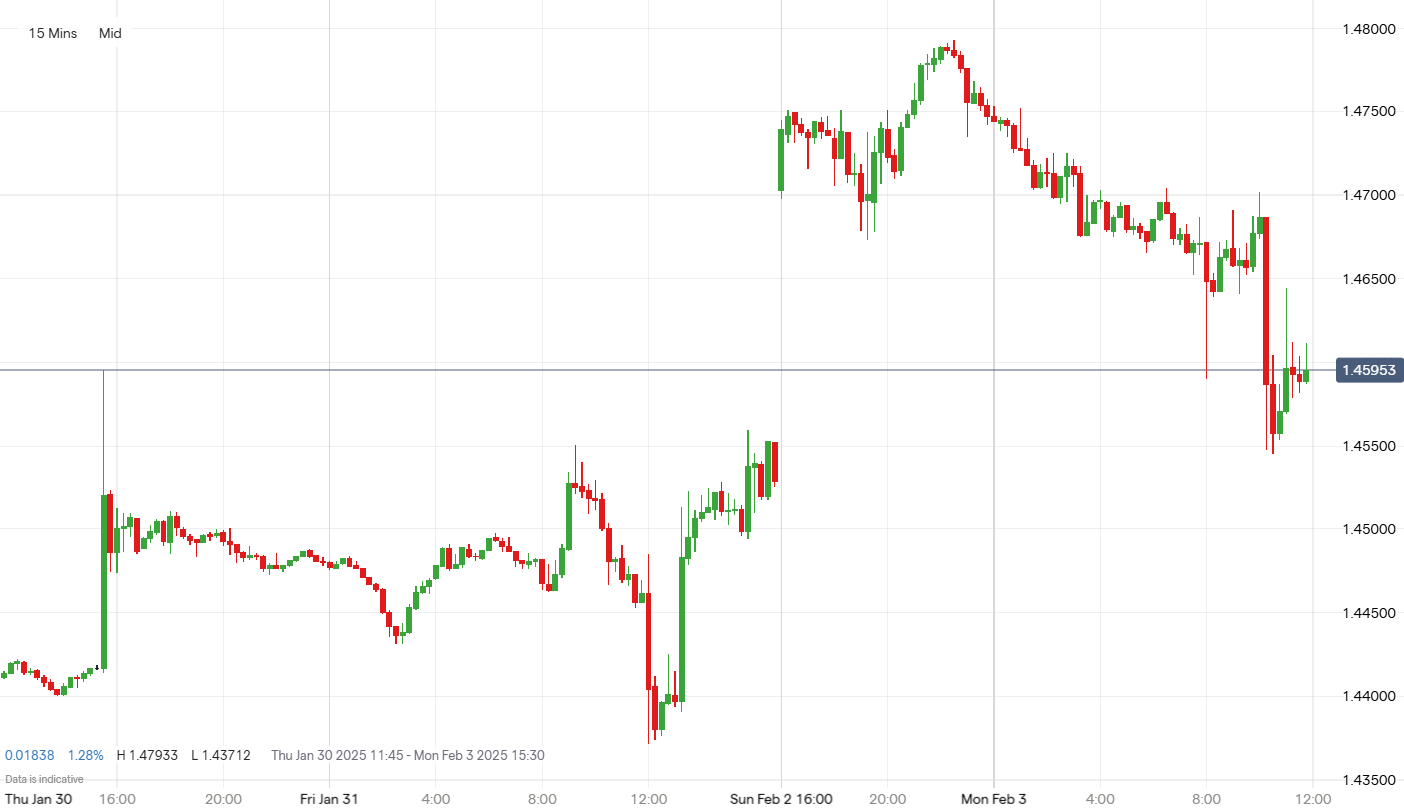US dollar surges to 20-year high on start of Trump tariffs
Explore how Trump's new tariffs are influencing major currency pairs, driving the US dollar to new heights, and sparking volatility amid global trade tensions.
.jpg?format=pjpg&auto=webp&quality=90&width=820&disable=upscale)
USD/CAD hits 1.4700 for first time since 2003
USD/CAD opened Sunday night above 1.4700, a level not seen since 2003, following an executive order from President Trump authorizing 25% tariffs on Canada. This order, signed on Saturday, is expected to take effect on February 4th, potentially diminishing US demand for Canadian goods. Such a reduction could negatively impact the Canadian economy, as the US is a primary trade partner. Consequently, the US dollar is strengthening against the Canadian dollar and other currencies sensitive to US tariff policies, illustrating the effect of geopolitical actions on currency pairs.
USD/CAD price history (15-min chart)

Peso crashes then rebounds amid tariff negotiations on Mexican imports
With the same order, President Trump authorized 25% tariffs on Mexican goods as well. Following the announcement, USD/MXN opened above 21.000, levels unseen since 2022. With the US being Mexico's top trade partner, these tariffs could significantly challenge Mexico's economy. Monday morning, the peso rebounded an astonishing 2.5% after Mexican President Sheinbaum announced Trump's tariffs would be delayed by one month due to her commitment in providing additional Mexican troops to border security. This has led to increased volatility in the USD/MXN pair, reflecting uncertainty over future trade measures. Traders should stay vigilant, as ongoing tariff developments may further influence this currency relationship in unpredictable ways.
Are the tariff talks over? Will other countries apply tariffs on the US?
In retaliation to US tariffs, Canada has imposed tariffs on over 1,000 US-produced items, with plans to expand this list. This escalation between the US and Canada may lead to a broader trade conflict, potentially involving European nations. Traders should be aware of how intensifying trade wars can disrupt market stability, impacting forex strategies and requiring a nimble response to ongoing developments in international trade policies.
Where is the US dollar going next?
The US dollar's recent appreciation is closely tied to the tariff policies affecting Canada, Mexico, and China. Speculation is growing that trade with the European Union will soon become a focus as well, potentially affecting the euro. Should further tariffs be imposed or existing ones escalate, the dollar could strengthen further. Conversely, any alleviation of trade pressures or a strategic shift away from tariffs could prompt a reversal in the dollar's trajectory. Forex traders must consider these uncertainties and align their strategies to potential shifts in US economic policies and their global repercussions.
How to trade USD pairs
- Open an account to get started, or practice on a demo account
- Choose your forex trading platform
- Find USD pairs to trade on the left navigation bar
- Open, monitor, and close positions on USD pairs
Trading forex requires an account with a forex provider like tastyfx. Many traders also watch major forex pairs like EUR/USD and USD/JPY for potential opportunities based on economic events such as inflation releases or interest rate decisions. Economic events can produce more volatility for forex pairs, which can mean greater potential profits and losses as risks can increase at these times.
You can help develop your forex trading strategies using resources like tastyfx’s YouTube channel. Our curated playlists can help you stay up to date on current markets and understanding key terms. Once your strategy is developed, you can follow the above steps to opening an account and getting started trading forex.
Your profit or loss is calculated according to your full position size. Leverage will magnify both your profits and losses. It’s important to manage your risks carefully as losses can exceed your deposit. Ensure you understand the risks and benefits associated with trading leveraged products before you start trading with them. Trade using money you’re comfortable losing. Past performance is not indicative of future results.
